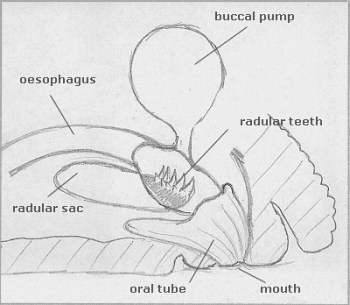Feeding in Acanthodoris pilosa
December 13, 2002
From: Derek
Dear Bill,
I was at this site and I am having some trouble finding how Acanthodoris pilosa eats. Right now I am a grade 10 high school student, and I am doing research on Acanthodoris for an Extra-curricular class: Marine Biology. I needed a whole bunch of information, but the only thing I can't seem to find is how it eats. If you gave me the information, I would be very grateful.
Thanks in Advance,
Derek
derek_the_great@emailaccount.com

Dear Derek,
Acanthodoris pilosa belongs to the family Onchidorididae, which mainly feed on bryozoans, or in one case, barnacles. What these food organisms all have in common is a hard external shell protecting the fleshy animal that the slugs want to eat. Acanthodoris feeds on Bryozoans which form a layer over hard surfaces. They are often called Lace Corals, because the colony consists of tiny calcareous cells, each one containing an individual animal. When dead the skeleton looks like a piece of fine lace work. Why I mention the nature of the bryozoan colony is because Acanthodoris when feeding, needs to be able to pick the individual animals out from their protective calcareous cells. Most dorid nudibranchs feed by scraping off parts of their food with their radular ribbon, which is a tongue-like structure, lined with many small teeth. In the onchidorids however, just scraping won't get their food out of its protective exoskeleton. So their radula is quite specialised with just two large teeth in each row which are used to pick out, or at least poke into the individual bryozoan cell. To help in getting the individuals out of each cell, onchidorids also have a unique buccal pump which acts like a little syringe, sucking the animal out of its protective case, after it is loosened by the radula.
To illustrate this feeding mechanism, I have made a quick sketch of the foregut of an onchidorid [with body wall removed]. The oral tube is a flexible tube which could be compared to a proboscis in some insects. It leads back to the buccal cavity in which the radula sits, and into which the large muscular buccal pump opens. During feeding, the radula is pushed forward to the mouth where it can pick around and loosen the bryozoan individuals. The buccal pump then sucks the food particles up into the buccal cavity and they are then moved back into the oesophagus, which leads to the stomach. If you don't understand any of this please let me know.
[If you us the SEARCH button at the top of each page to look for 'radula' you will find photos of many different types of radula. Unfortunately I haven't a good photo of the teeth of Acanthodoris. There is a very complete study, by Crampton, of the foregut of the similar Onchidoris bilamellata which I list below. For anyone wanting a complete description of the musculature and histology of the tissues its the place to go.
• Crampton, D.M. (1977) Functional anatomy of the buccal apparatus of Onchidoris bilamellata (Mollusca: Opisthobranchia). Transactions of the Zoological Society of London, 34: 45-86.
Good Luck with your project,
Bill Rudman
Related messages
-
Acanthodoris pilosa from Puget Sound
From: Richard L. Zade, March 17, 2008 -
Re: Acanthodoris pilosa from British Columbia
From: J. Hildering & G. Miller, November 6, 2007 -
Re: Adalaria? Akiodoris? from Denmark
From: Sven Gust, June 25, 2007 -
Re: Adalaria? Akiodoris? from Denmark
From: Alexander Martynov, June 21, 2007 -
Adalaria? Akiodoris? from Denmark
From: Sven Gust, June 20, 2007 -
Re: Acanthodoris pilosa? - color variation
From: Alan Shepard, April 30, 2003 -
Acanthodoris pilosa? - color variation
From: Alan Shepard, March 25, 2003 -
Re: Identity of Acanthodoris pilosa
From: Ron Velarde, December 13, 2002 -
Information on Acanthodoris pilosa
From: Alma Sánchez, December 12, 2002 -
Identity of Acanthodoris pilosa
From: Bernard Picton, December 12, 2002 -
Acanthodoris pilosa and egg ribbons
From: Bernard Picton , July 23, 2002 -
Acanthodoris pilosa from Ireland
From: Bernard Picton , July 22, 2002 -
Re: Adalaria proxima? from Massachusetts
From: Bernard Picton, July 12, 2002 -
Re: Adalaria proxima? from Massachusetts
From: Irina Roginskaya, July 12, 2002 -
Adalaria proxima? from Massachusetts
From: Andrew Martinez , July 11, 2002 -
Acanthodoris pilosa from British Columbia
From: Marli Wakeling, May 29, 2002 -
Re: Adalaria? from British Colombia
From: Jeff Goddard, March 18, 2001 -
Re: Adalaria? from British Columbia
From: Alexander Martynov, March 18, 2001 -
Adalaria? from British Columbia
From: Marli Wakeling, March 15, 2001 -
Acanthodoris pilosa for the layman
From: John Pancharian, December 31, 2000 -
Acanthodoris pilosa from Holland
From: Peter H. van Bragt, August 25, 1999
